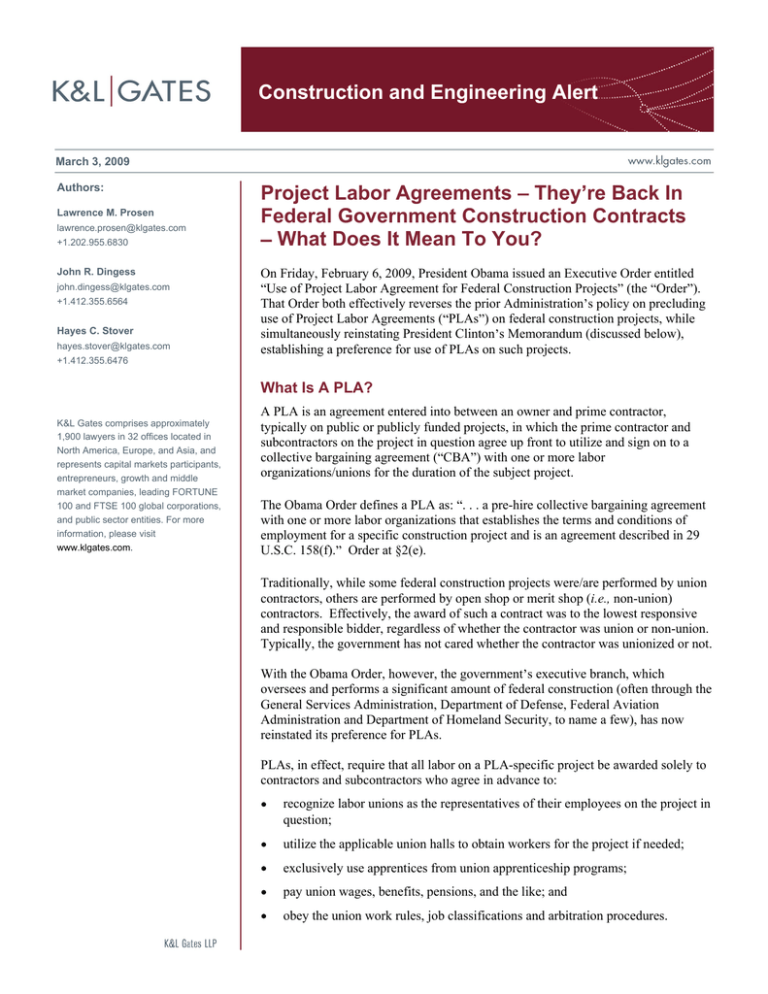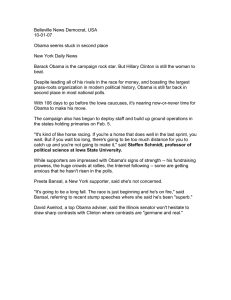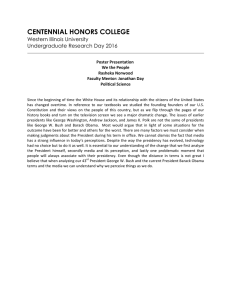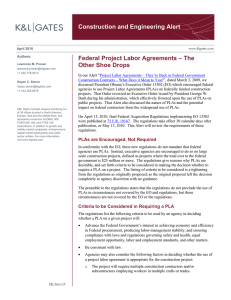
Construction and Engineering Alert
March 3, 2009
Authors:
Lawrence M. Prosen
lawrence.prosen@klgates.com
+1.202.955.6830
John R. Dingess
john.dingess@klgates.com
+1.412.355.6564
Hayes C. Stover
hayes.stover@klgates.com
Project Labor Agreements They re Back In
Federal Government Construction Contracts
What Does It Mean To You?
On Friday, February 6, 2009, President Obama issued an Executive Order entitled
Use of Project Labor Agreement for Federal Construction Projects (the Order ).
That Order both effectively reverses the prior Administration s policy on precluding
use of Project Labor Agreements ( PLAs ) on federal construction projects, while
simultaneously reinstating President Clinton s Memorandum (discussed below),
establishing a preference for use of PLAs on such projects.
+1.412.355.6476
What Is A PLA?
K&L Gates comprises approximately
1,900 lawyers in 32 offices located in
North America, Europe, and Asia, and
represents capital markets participants,
entrepreneurs, growth and middle
market companies, leading FORTUNE
100 and FTSE 100 global corporations,
and public sector entities. For more
information, please visit
www.klgates.com.
A PLA is an agreement entered into between an owner and prime contractor,
typically on public or publicly funded projects, in which the prime contractor and
subcontractors on the project in question agree up front to utilize and sign on to a
collective bargaining agreement ( CBA ) with one or more labor
organizations/unions for the duration of the subject project.
The Obama Order defines a PLA as: . . . a pre-hire collective bargaining agreement
with one or more labor organizations that establishes the terms and conditions of
employment for a specific construction project and is an agreement described in 29
U.S.C. 158(f). Order at §2(e).
Traditionally, while some federal construction projects were/are performed by union
contractors, others are performed by open shop or merit shop (i.e., non-union)
contractors. Effectively, the award of such a contract was to the lowest responsive
and responsible bidder, regardless of whether the contractor was union or non-union.
Typically, the government has not cared whether the contractor was unionized or not.
With the Obama Order, however, the government s executive branch, which
oversees and performs a significant amount of federal construction (often through the
General Services Administration, Department of Defense, Federal Aviation
Administration and Department of Homeland Security, to name a few), has now
reinstated its preference for PLAs.
PLAs, in effect, require that all labor on a PLA-specific project be awarded solely to
contractors and subcontractors who agree in advance to:
recognize labor unions as the representatives of their employees on the project in
question;
utilize the applicable union halls to obtain workers for the project if needed;
exclusively use apprentices from union apprenticeship programs;
pay union wages, benefits, pensions, and the like; and
obey the union work rules, job classifications and arbitration procedures.
Construction and Engineering Alert
As a result, both union and non-union contractors
must sign on to the union CBAs for purposes of the
project in question.
continued throughout the balance of the Clinton
presidency, but was limited to projects costing in
total more than $5 million.
History Of Presidential Use Of PLAs
B. Bush II s Executive Order
As exemplified by a change in office, often
significant policy changes are effectuated with the
entry of a new president. For example, the George
W. Bush Administration took a diametrically
opposed view of PLAs from that set forth in the
Clinton Memorandum. On February 17, 2001,
President Bush issued Executive Order No. 13202,
entitled Preservation of Open Competition and
Government Neutrality Towards Government
Contractors Labor Relations on Federal and
Federally Funded Construction Projects. This
Order was amended by Executive Order 13208,
dated April 6, 2001 (the Bush Order ).
For the most part, until the 1990s U.S. presidents did
little policy-wise to endorse the use or preference for
open shop or union labor on federal or federally
funded construction projects. There is little history
of presidents of the United States asserting their
authority and power in requiring or preferring the
use or non-use of union labor on a given project.
A. The Clinton Memorandum
That history changed, however, when on June 5,
1997, President Bill Clinton issued his
Memorandum on Use of Project Labor Agreements
for Federal Construction Projects
( Memorandum ). That Memorandum stated, in
short, that in order to implement rigorous
performance standards, minimize costs, and
eliminate wasteful and burdensome requirements,
the president by issuing his Memorandum was
encourage[ing] departments and agencies in this
Administration to consider project labor agreements
in governmental contracting, to achieve economy
and efficiency in Federal construction projects.
As a result, President Clinton directed that the
agencies and executive departments under his
authority were authorized to, on a project-byproject basis, use a project labor agreement on a
large and significant project, (a) where a project
labor agreement will advance the Government s
procurement interest in cost, efficiency, and quality
and in promoting labor-management stability as well
as compliance with applicable labor requirements
governing safety and health, equal employment
opportunity, labor and employment standards, and
other matters . . . .
The determination as to whether to use a PLA on a
given project was left to the agency s/department s
discretion. If, however, the agency/department
elected to require a PLA, then the
department/agency was permitted to . . . require
that every contractor or subcontractor on the project
agree, for that project, to negotiate or become a party
to a project labor agreement with one or more
appropriate labor organizations. This policy
When read together, the Bush Order states, in
relevant part, that the federal government would
reverse the Clinton Memorandum so that the
government could: (1) promote and ensure open
competition on Federal and federally funded or
assisted construction projects; (2) maintain
Government neutrality towards government
contractors labor relations on Federal and federally
funded or assisted construction projects; (3) reduce
construction costs to the Federal Government and to
the taxpayers; (4) expand job opportunities,
especially for small and disadvantaged businesses;
and (5) prevent discrimination against Government
contractors or their employees based upon labor
affiliation or lack thereof; thereby promoting the
economical, nondiscriminatory, and efficient
administration and completion of Federal and
federally funded or assisted construction projects.
As a result, the Bush Order stated that all executive
agencies obligating funds to, or awarding,
construction contracts were required to make sure
that neither the awarding governmental entity nor
any construction manager acting for the government
mandate or prohibit any bidder, offeror, contractor,
or subcontractor to enter into, or comply with,
agreements with labor organizations on the same or
related construction projects. The agency also could
not take other actions that would discriminate
against bidders, offerors, contractors, or
subcontractors for either signing or refusing sign on,
March 3, 2009
2
Construction and Engineering Alert
or otherwise adhere, to such labor agreements on the
same or other related construction project.
Comparison of the Bush Order with the Clinton
Memorandum reveals that the executive branch of
the U.S. government completely reversed course,
from a preference for PLAs under Clinton to an
absolute bar on any preference or non-preference for
PLAs under Bush II.
C. The Obama Executive Order
As discussed in the following section, President
Obama has reversed course from the prior
Administration and instead followed the same path
as President Clinton s Memorandum.
Current Policy
The recent Obama Order yet again reverses
direction, effectively retracting the Bush Order and
reinstating in an executive order format the Clinton
Memorandum, albeit with one significant change.
While the Obama Order reinstates the preference for
PLAs on federal construction projects or on
federally funded projects, instead of the $5 million
threshold set forth by President Clinton, President
Obama has established a $25 million floor.
This $25 million level represents what the Obama
Administration calls a large-scale construction
project. In furtherance of this finding, the Obama
Order states that:
Section 1. Policy. (a) Large-scale
construction projects pose special
challenges to efficient and timely
procurement by the Federal
Government. Construction
employers typically do not have a
permanent workforce, which makes
it difficult for them to predict labor
costs when bidding on contracts
and to ensure a steady supply of
labor on contracts being performed.
Challenges also arise due to the fact
that construction projects typically
involve multiple employers at a
single location. A labor dispute
involving one employer can delay
the entire project. A lack of
coordination among various
employers, or uncertainty about the
terms and conditions of
employment of various groups of
workers, can create frictions and
disputes in the absence of an
agreed-upon resolution
mechanism. These problems
threaten the efficient and timely
completion of construction projects
undertaken by Federal contractors.
On larger projects, which are
generally more complex and of
longer duration, these problems
tend to be more pronounced.
(b) The use of a project labor
agreement may prevent these
problems from developing by
providing structure and stability to
large-scale construction projects,
thereby promoting the efficient and
expeditious completion of Federal
construction contracts.
Accordingly, it is the policy of the
Federal Government to encourage
executive agencies to consider
requiring the use of project labor
agreements in connection with
large-scale construction projects in
order to promote economy and
efficiency in Federal procurement.
As discussed above with regard to the Clinton
Memorandum, and given the Obama-stated policy
position, the Obama Order likewise grants
discretion to the executive agencies and departments
as to whether to require the use of PLAs on largescale projects, and then on a project-by-project
basis. In electing to assert a PLA, it appears that the
agency will need to make an affirmative showing
that the imposition of such a PLA will further the
government s interests in achieving economy and
efficiency in Federal procurement, producing labormanagement stability, and ensuring compliance
with laws and regulations governing safety and
health, equal employment opportunity, labor and
employment standards and other matters . . . . See
Obama Order at §3(a).
March 3, 2009
3
Construction and Engineering Alert
Given this agency discretion and the present political
climate, it is likely that PLAs will be required on
many, if not most, applicable projects.
With this in mind, however, where PLAs are
required on federal procurements, the PLA is
required to:
(a) bind all contractors and subcontractors on
the construction project through the inclusion of
appropriate specifications in all relevant
solicitation provisions and contract documents;
(b) allow all contractors and subcontractors to
compete for contracts and subcontracts without
regard to whether they are otherwise parties to
collective bargaining agreements;
(c) contain guarantees against strikes, lockouts,
and similar job disruptions;
(d) set forth effective, prompt, and mutually
binding procedures for resolving labor disputes
arising during the project labor agreement;
(e) provide other mechanisms for labormanagement cooperation on matters of mutual
interest and concern, including productivity,
quality of work, safety, and health; and
(f) fully conform to all statutes, regulations, and
Executive Orders.
See Obama Order at §4.
These requirements and limitations make it clear,
among other things, that: (1) the imposition of a
PLA on a given project is not required, but left to the
agency s discretion; (2) if a PLA is set in place, it is
applicable to all contractors and subcontractors on
the project; (3) all contractors, regardless of union
affiliation, have a right to compete for federal work;
(4) guarantees against strikes and other similar labor
unrest are required; and (5) binding and prompt
dispute resolution processes must be established in
the PLA.
Interestingly, the stated policy bases for the Obama
Order appear to include the mitigation of possible
labor unrest during the project, avoidance of
discrimination and assertion of other applicable
labor standards. In reality, most of these policy
bases have already been met and apply on federal
construction projects. For example, as to hourly
wages and benefits, the Davis-Bacon Act, 40 U.S.C.
§276a et al. provides that all contractors on a federal
project must pay at a minimum the Department of
Labor ( DOL ) established prevailing wages to
their employees. Those wages include both hourly
wages plus benefits as denoted in the applicable
prevailing wage determination appended to the
contract. Most of the time these prevailing wages
are determined by the DOL s looking at the local
union wages and benefits and inserting them
verbatim into their wage determination. Therefore,
both union and non-union contractors are paying at
least the union wage on federal construction
projects. See 48 C.F.R. Subpart 22.4.
Similarly, as a matter of policy, all contractors on a
federal project are required to comply with
applicable non-discrimination and affirmative
action, including EEOC and other like minority
programs. See, e.g., 48 C.F.R. Subparts 22.8 (Equal
Employment Opportunity) and 22.9
(Nondiscrimination Because of Age).
These and other like policies already in place appear
to address the majority of the concerns raised in the
Obama Order. It bears mention that the Order is
effective only for solicitations made after the new
FAR regulations are issued, which in this case
would be at least 120 days from the Order s date.
Another important note is Order Section 7. That
Section requires the Office of Management and
Budget Director in consultation with the Secretary
of Labor and with other officials as appropriate, to
provide President Obama within 180 days of this
order, recommendations about whether broader use
of project labor agreements, with respect to both
construction projects undertaken under Federal
contracts and construction projects receiving
Federal financial assistance, would help to promote
the economical, efficient, and timely completion of
such projects. Therefore, it is possible that the
scope and breadth of the present Obama Order may
be modified, likely by expanding its scope to other
project sizes/types. Only time will determine if this
expansion takes place.
What Does This Mean For Me?
There has been a long debate among union and nonunion construction organizations as to the true
March 3, 2009
4
Construction and Engineering Alert
impacts of PLAs on projects. This debate ranges
from topics such as costs, efficiencies, timeliness of
performance and other like issues. This Alert does
not discuss these issues or intend to enter into this
debate.
With this in mind, however, if you perform federal
construction work, regardless of union affiliation,
you need to be aware of the possibility that your
future projects (which exceed total costs of $25
million under the Obama Order) may be subject to a
PLA and the associated use of union labor and/or
need to budget for union dues, fees, benefits and
wages.
If you are a merit or open shop contractor and/or are
not otherwise familiar with union-based projects,
then it is incumbent upon you to learn the intricacies
of PLAs and unionized projects. You also need to
familiarize yourself with the labor laws associated
with unfair labor practices, and other aspects of
labor and employment law to verify your
compliance with such rules and regulations.
Conclusions
The Obama Executive Order is not a sea change
from prior government policy, but it is a significant
revision from the Bush Administration. The Obama
Order does not mandate or compel the use of PLAs.
With this in mind, however, federal executive
agencies are now armed with the discretion of
imposing PLAs on any federal project or federally
financed construction project with a total value
(presumably inclusive of design and other preconstruction/pre-award costs) of $25 million or
more.
This Order impacts both open shop and union
contractors and subcontractors in a number of ways,
possibly imposing new requirements on both
classifications of contractor.
With the stimulus becoming law on February 17,
the possibility for the imposition of PLAs on many
of the projects resulting from that package is
significant. Federal construction contractors and
subcontractors alike need to be aware of these
requirements and how best to address the challenges
they impose.
K&L Gates comprises multiple affiliated partnerships: a limited liability partnership with the full name K&L Gates LLP qualified in Delaware and
maintaining offices throughout the U.S., in Berlin and Frankfurt, Germany, in Beijing (K&L Gates LLP Beijing Representative Office), in Singapore
(K&L Gates LLP Singapore Representative Office), and in Shanghai (K&L Gates LLP Shanghai Representative Office); a limited liability partnership
(also named K&L Gates LLP) incorporated in England and maintaining our London and Paris offices; a Taiwan general partnership (K&L Gates)
which practices from our Taipei office; and a Hong Kong general partnership (K&L Gates, Solicitors) which practices from our Hong Kong office.
K&L Gates maintains appropriate registrations in the jurisdictions in which its offices are located. A list of the partners in each entity is available for
inspection at any K&L Gates office.
This publication is for informational purposes and does not contain or convey legal advice. The information herein should not be used or relied upon
in regard to any particular facts or circumstances without first consulting a lawyer.
©2009 K&L Gates LLP. All Rights Reserved.
.
March 3, 2009
5







